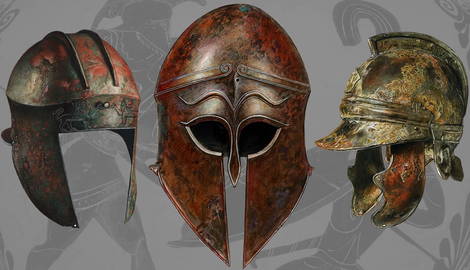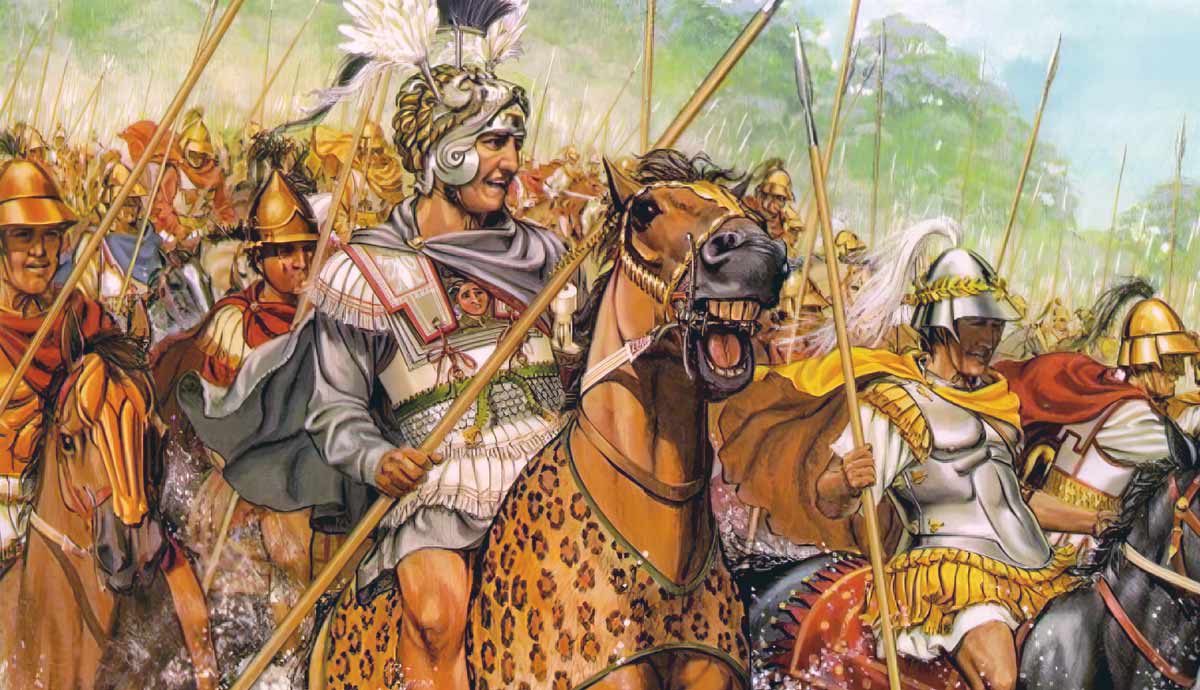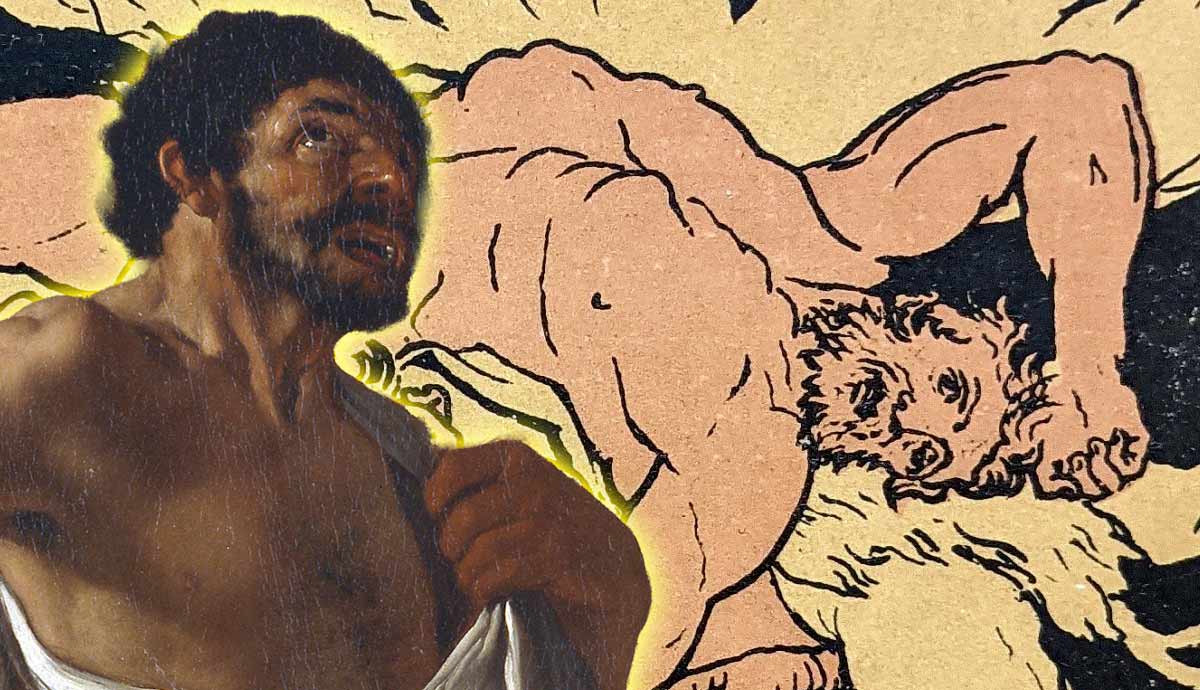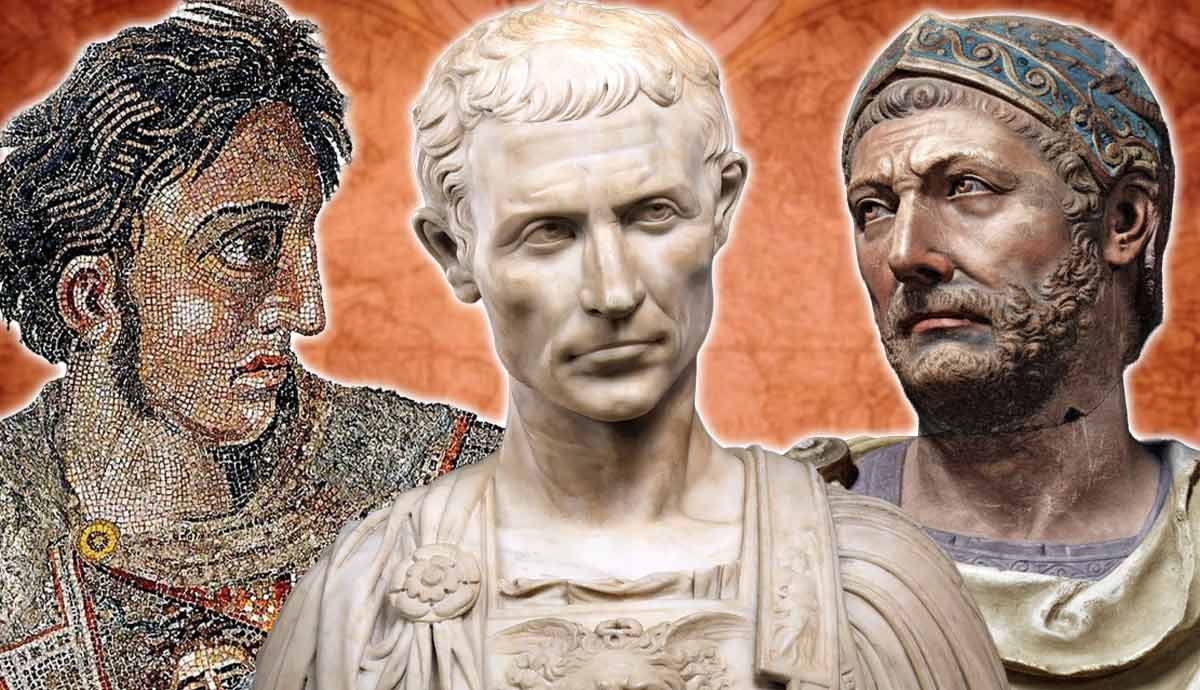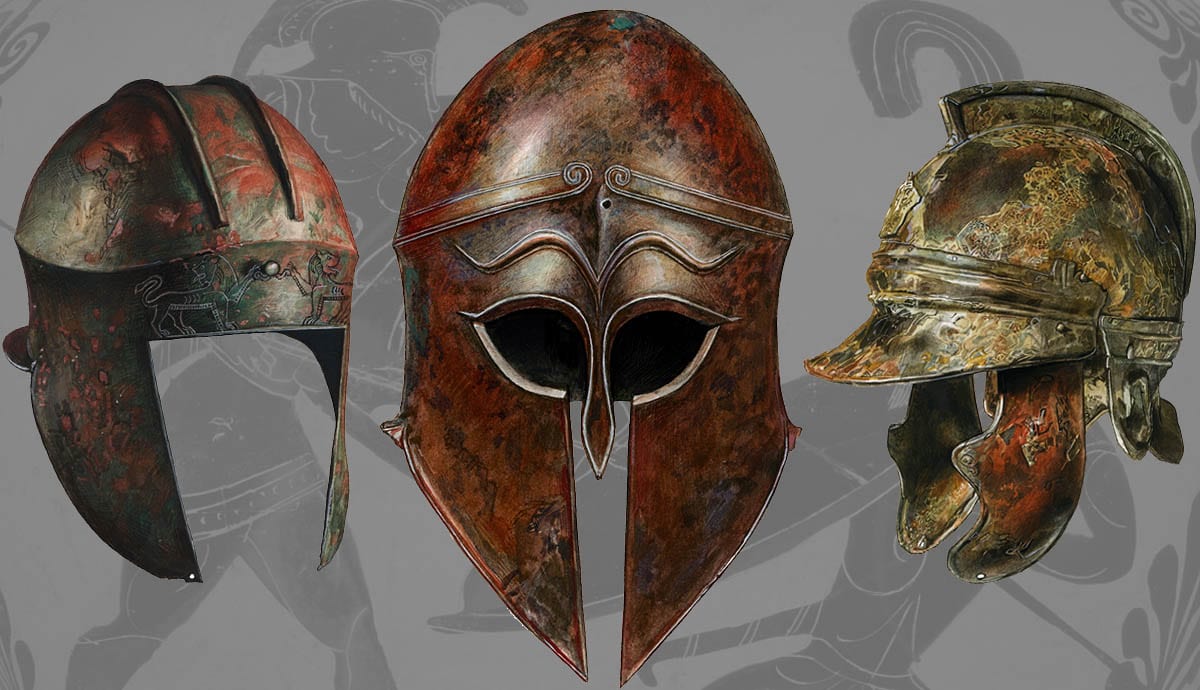
The Ancient Greeks were, from the Archaic to the Hellenistic period, famous for their armor. Few soldiers or warriors went into battle as heavily armored as did the Ancient Greeks. While their panoply changed over the centuries, there was one piece of armor which remained ubiquitous; the Ancient Greek helmet. The Ancient Greek helmet evolved over time to meet the needs of the battlefield and appeal to the taste of those who wore them. Examples of Greek helmets in Classical Antiquity range the fabulously elaborate to the plain and simple. Yet, all ultimately served the same utilitarian purpose; providing protection on the battlefield.
Kegel: The “Original” Ancient Greek Helmets

While helmets certainly existed during the Bronze Age, too few have survived to establish a comparative typology with the possible exception of Boar Tusk helmets. As such, the earliest Ancient Greek helmet well-represented in the archaeological record is the Kegel type, which emerged during the Geometric period at the end of the Greek Dark Age. These helmets appear to have originated in the Peloponnese, possibly somewhere near the city of Argos. Examples of Kegel helmets have been found in the Peloponnese, Apulia, Rhodes, Miletus, and Cyprus. Kegel type helmets appear to have fallen out of use sometime after the end of the Eighth Century BC.

Ancient Greek helmets of the Kegel type were constructed out of several bronze segments. These segments were separately cast and then bent and riveted together. It was a laborious process, which also resulted in a relatively weak final product. Kegel type helmets were liable to bursting apart at the seams if struck by an enemy. These helmets also exhibit two distinct stylistic trends. The first, and most common, is a pointed crown section where a high crest was attached. The second has a rounded dome, with tall elaborate zoomorphic crest holders. Kegel helmets of this style have, to date, only been excavated in Apulia.
Illyrian: The Open-Faced Ancient Greek Helmets

Attempts to overcome the deficiencies of the Kegel type helmet resulted in two new types of Ancient Greek helmet. The first of these was the Illyrian type which emerged in the Seventh Century BC. These helmets also appear to have originated in the Peloponnese but were popular throughout the Mediterranean world, as they were a popular trade good. Examples have been excavated in Greece, Macedonia, the Balkans, the Dalmatian coast, the Danubian region, Egypt, and Spain. Outside of the Peloponnese, Macedonia was a major producer of Illyrian helmets. The Illyrian type of Ancient Greek helmet began to fall out of use during the Fifth Century BC as it was replaced by newer, more versatile, designs.

Ancient Greek helmets of the Illyrian type featured a large opening for the face and prominent fixed cheekpieces. These helmets always had a quadrangular opening for the face, featured no curvature for the mouth or eyes, and lacked any type of nose guard. They also featured parallel raised lines that formed channels running from the front to the back of the helmet, that were designed to accommodate a crest.
These helmets are further divided into three distinct types. The first type of Illyrian helmets were made of two separate pieces which were then riveted together. Once Illyrian helmets began to be cast as one piece a second type soon emerged. This type featured a swooping neck guard, elongated cheek pieces, and a more pronounced crest channel. The third type was much simpler in form than its predecessors. These helmets no longer featured a riveted border, and the neck guard became more angular and abbreviated; this was a streamlined design.
Corinthian: The Archetypal Helmets Of Classical Antiquity

The other type of Ancient Greek helmet which developed from attempts to overcome the deficiencies of the Kegel type was the Corinthian type. The Corinthian helmet was also developed in the Peloponnese during the Seventh Century BC. These Ancient Greek helmets quickly spread throughout the Mediterranean world during Classical Antiquity and have been excavated in Greece, Italy, Sicily, Sardinia, Spain, Serbia, Bulgaria, the Crimea, and Crete. They were perfectly suited for hoplites fighting in the phalanx formations that characterized warfare in Greece. Corinthian helmets were very popular during Classical Antiquity and became closely associated with Greece, Greek culture, and hoplites. As such, the iconic Corinthian helmet was often depicted in art. In his Histories, Herodotus was the first to use the term “Corinthian helmet,” although it is not certain that he was referring specifically to this type of helmet. Corinthian helmets remained in use for nearly three hundred years, falling out of fashion by the end of the Fifth Century.

Corinthian type Ancient Greek helmets are characterized by their distinctive almond-shaped eyeholes, prominent nose guard, and large cheek pieces which are never rounded or hinged, and cover the entire face. The overall impression of the Corinthian helmet is one of theatrical menace. Early Corinthian helmets were made of two pieces riveted together, with the seam running along the circumference of the helmet. They also included rivet holes for attaching a liner. The second type of Corinthian helmet added an abbreviated swooping or angular neck guard at the back. The rivet holes also shrunk or were done away with at this point, and the cheek pieces now flared outward slightly.
In the first decades of the Sixth Century BC, the Corinthian helmet achieved its classical form. It was now cast so that it was more bulbous around the upper part while the lower edge flared slightly. The lines for the face were more carefully thought out and delineated. Most notably, the openings for the eyes were elongated at the ends, giving them their distinctive almond appearance. Corinthian helmets were very popular and were produced over a long period of time in many distinct regional workshops, so that many styles exist.
Chalcidian: The Lighter Ancient Greek Helmet

As the nature of warfare changed a new Ancient Greek helmet was developed some time during the second half of the Sixth Century BC. Greek armies began to incorporate more cavalry and lightly armed troops into their ranks, so that pitched battle between evenly matched phalanxes became rarer. As a result, it was necessary for soldiers to have a better perception of the battlefield. The result was the Chalcidian helmet which restricted the senses less than the Corinthian helmet but provided more protection than the Illyrian helmet. Early examples of Chalcidian helmets were very similar to the Corinthian helmet and likely were initially produced alongside them in the same workshops. The Chalcidian helmet has one of the widest geographic distribution ranges of excavated Ancient Greek helmets. Examples have been found from Spain to the Black Sea, and as far north as Romania.

The Chalcidian type Ancient Greek helmet was essentially a lighter and less restrictive form of Corinthian helmet. Its cheek pieces were less pronounced than those of the Corinthian helmet and were either rounded or curvilinear. Later Chalcidian helmets had hinged cheek pieces that were anatomically formed to fit closely to the face. The cheekpieces tended to curve upward towards the eye, where there were large circular openings that provided a wider field of view than did Corinthian helmets. Chalcidian helmets also always featured an opening for the ear and a neck guard, which conformed closely to the contours of the back of the neck and terminated in a flanged lower border. Chalcidian helmets are largely characterized by their cheek pieces so that most of the many surviving examples can be divided into several distinct regional types.
Phrygian or Thracian: The Crested Ancient Greek Helmets

An Ancient Greek helmet known as the Phrygian or Thracian type developed from the Chalcidian helmet sometime in the late Sixth Century BC. These helmets mimicked the forward-leaning felt shepherd’s cap which was associated with the region of Phrygia in Anatolia. However, these helmets appear to have been found almost exclusively in ancient Thrace, an area which today consists of parts of Greece, Turkey, and Bulgaria. As such, this style of helmet has been referred to as both the Phrygian and Thracian helmet. During Classical Antiquity there were numerous Greek colonies and city-states in this region, which had a close relationship with mainland Greece. Phrygian type helmets appear to have reached the height of their popularity during the Hellenistic period and only fell out of use with the rise of Rome.

The Phrygian type helmet developed from the Chalcidian helmet as a regional offshoot. It is distinguished by its large forward-leaning crest, which was originally a separate piece riveted together. The lower border of the crest was both recessed and flanged outward to form a visor over the wearer’s brow. The neck guard was designed to conform closely to the anatomy of the wearer and left an opening for the ear. Cheek pieces were always separately made and hinged just below the visor. Interestingly the cheekpieces were often decorated to mimic facial hair and these designs grew more elaborate over time. Some cheek pieces not only mimicked facial hair but also conformed to the contours of the mouth and nose.
Attic: The Iron Ancient Greek Helmets

Few examples of the Ancient Greek helmet known as the Attic type have survived to the current day. This type of helmet first developed in the latter half of the Fifth Century, but did not reach the height of its popularity until the Fourth Century BC. Unlike most Ancient Greek helmets, the Attic helmet was often made of iron rather than bronze, which means that fewer have survived due to oxidation or corrosion. However, the use of iron in the construction of these helmets suggests that they were more common than the number of surviving examples would suggest, as iron was a more readily available commodity than bronze.

Ancient Greek helmets of the Attic type are close-fitting and highly varied. Their distinctive features include a pediment over the brow and an elongated visor. They also have a crest attachment running from the back of the helmet, which terminates at the front, hinged cheek pieces with an anatomical form, and a neck guard that conforms closely to the neck while leaving an opening for the ear. Some surviving examples of Attic type helmets were elaborately decorated, demonstrating a high level of craftsmanship.
Boeotian: The Cavalrymen’s Ancient Greek Helmet

The Ancient Greek helmet known as the Boeotian helmet emerged sometime in the Fourth Century BC. Boeotian helmets form the smallest distinct group of Ancient Greek helmets that have survived to the modern era. As with the Attic helmet, several surviving Boeotian helmets were made from iron, so many may have been lost to corrosion. Like the Corinthian helmet, the Boeotian helmet was also mentioned in the ancient sources. Xenophon, a Greek general and historian, recommended the Boeotian helmet for cavalrymen in a treatise about horsemanship. In fact, the Boeotian helmet is the only Ancient Greek helmet that is still known by its correct ancient name; something that we can say with certainty. Compared to other types of Ancient Greek helmets the Boeotian helmet is far more open, providing a cavalryman with an unparalleled field of view.

Boeotian type Ancient Greek helmets resemble a mix of the upright Phrygian helmet with a visor and the closer fitting Attic helmet with hinged cheekpieces. According to the strictest possible interpretations, this helmet appears in the form of a folded down horseman’s hat. It has a large, rounded upper dome with a large swooping visor that extends out in the front and back. Other helmets of this type have a raised pediment over the brow, like an Attic helmet, or a pointed top like a Pilos helmet. The visors of these types of Boeotian helmets are much more abbreviated; which is compensated for by hinged cheek piece.
Pilos: The Conical Ancient Greek Helmets

Pilos helmets were the simplest type of Ancient Greek helmet. While these helmets certainly could have been made and used at an early date, and seem to have originated in the mid-Sixth Century BC, most examples date to the Fourth or Third Century BC. The popularity of Pilos helmets at this time was largely a reflection of the changing nature of warfare. Hellenistic soldiers had a greater need to see and hear on the battlefield than did their Archaic and Classical counterparts. Since Pilos helmets were so simple to make they were popular with armies throughout the Hellenistic world.

Ancient Greek helmets of the Pilos type consisted of nothing more than a simple upright conical form. They also feature a recessed band along the lower edge, which produces a carinated upper section. While many other features were added to the Pilos helmet at various times, this basic form remained unchanged. Some, for example, mimicked the appearance of a folded cap with a rolled back visor and a backward leaning peak. Others featured hinged cheek pieces and elaborate crest attachments such as wings and horns.
Special thanks to Randall Hixenbaugh for his invaluable and kind assistance with this article. Randall has assembled a vast database of 2100 ancient Greek Helmets. The illustrations used in this article were created by Alexander Valdman whose work has appeared in over 120 books and magazines. They were graciously provided for use in this article by courtesy of Randall Hixenbaugh and can be found in his and Alexander Valdman’s book: Ancient Greek Helmets: A Complete Guide and Catalog.
